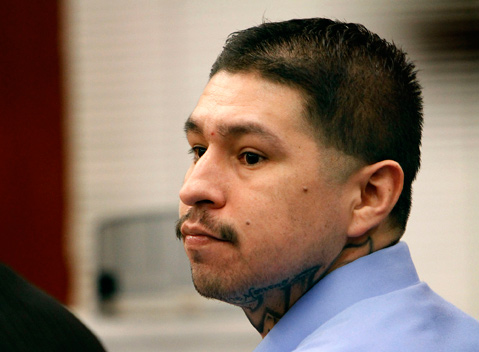‘Big Homie’ or Bumbling Gang Boss?
Santa Maria Jurors to Determine Who the Real Ray Macias Is

When Raymond Macias, a well-known leader of the East Side Krazies street gang, was arrested last June on torture and extortion charges, law enforcement officials crowed they’d just nabbed Mister Big, or as he would be described throughout the four-week criminal trial that just concluded in Santa Maria, “the Big Homie.” At the time of his arrest, Macias was described as a major drug lord and Santa Barbara County’s top tax collector for the Sureños, a fearsome Southern California prison gang with connections to the even more fearsome Mexican Mafia.
Specifically, he was charged with kidnapping Lompoc drug dealer and gang member Stephen Mendibles when Mendibles failed to make good on a $1,100 debt he owed Macias. In her final words to the jury, prosecuting attorney Anne Bramsen sought to reinforce this theme. “Mr. Macias condones violent behavior,” she said. “He engages in violent behavior.”
In stark contrast, Macias’s attorney, Michael Scott, spent the better part of two hours portraying his client as a bumbling, stumbling, “weak” gang boss. Macias, said Scott, gave deadbeat drug dealers too many chances, making repeated “courtesy visits” to those who owed, and often paying off their debts out of his own pocket. Yes, Scott admitted, Macias was a drug dealer, a Sureño gang member, and even a tax collector. But he should not be confused with Tony Montana, the bloodthirsty drug dealer of Scarface fame. Nor should he be equated with the calculating cunning of Machiavelli or the corporate ruthlessness of Henry Ford. What kind of criminal mastermind, Scott wondered, left incriminating text messages on his cell phone or kept receipts in his apartment of Western Union payments he’d wired to the Mexican Mafia?
Both sides agree that early last January, Macias put out the word he wanted “to talk” with Mendibles. Both sides agree that after two courtesy visits, Mendibles went into hiding. Eventually, he was found by members of the Lompoc gang, VLP, and taken to a garage, where it was understood he was to be beaten. The beating was part of a gang practice known as “checking,” in which those who violate protocol are soundly thrashed by a larger group of gang members. They are expected, however, to fight back. In this case, Mendibles quickly got the better of his attackers. Luis Almanza, an alleged enforcer with gang ties from Texas, picked up a hatchet and whacked Mendibles twice, once on the arm and once on the side. (Almanza was also on trial for extortion and torture.) Mendibles, who never sought medical treatment for his injuries, testified his arm remains injured from the attack.
All sides agree Macias was not present for any of this and only arrived 90 minutes later. He untied Mendibles and let him go, though not before notifying Mendibles he had three days to heal, after which he would be “poked” with a knife. Many of the gang members who participated in the attack testified they were acting on what they believed to be Macias’s orders. It came out during the trial that Macias’s younger brother had been recently checked by Mendibles, sustaining a fractured cheek and broken arm in the process.
Scott countered that Macias never ordered any such thing and was “shocked” that Almanza “went off the rails.” Neither a VLP nor a Sureño, Almanza reportedly lacked the gang standing to strike Mendibles in a formal checking. Likewise, Scott pointed out that those who testified against Macias made deals with the prosecution to get more lenient sentences. He also noted that Philip Lopez, who was involved in the “checking,” harbored a serious grudge against Mendibles, who reportedly had sex with Lopez’s girlfriend when Lopez was in prison.
In closing arguments, Scott sought to persuade the jury that Macias could never have known that by indicating an interest in merely “talking” with Mendibles, he would trigger such an improbable chain of events. “That’s not reasonably foreseeable,” he insisted. Improbable, yes, Bramsen retorted, but quite possible and easily imaginable. At the time, she noted, two North County gang members had recently been murdered for not paying taxes on their drug sales. Perhaps her single most damning evidence was a video of Macias speaking to his girlfriend while in county jail, saying — in gang sign language — “He was there when I had [Mendibles].”
In the past year, law enforcement officials have expressed concern that the Mexican Mafia has emerged as a more serious presence in Santa Barbara’s scene. That was certainly one of the key issues raised during the four-week trial on the City of Santa Barbara’s proposed gang injunction, a trial that concluded three weeks ago. In that trial, prosecutors made much of testimony by longtime gang member Arthur Nevarez, who claimed that the reduction in violent gang activity throughout the South Coast reflected the wishes and direction of the Mexican Mafia. Nevarez, now an informant who participated in an anti-gang documentary, testified gang violence is bad for business because it attracts law enforcement attention.
Macias was named in the city’s proposed gang injunction, and though he was not present in Judge Colleen Sterne’s courtroom, his name was frequently invoked by prosecutors to buttress Nevarez’s claim. At the time of his arrest, Macias was on the payroll of Palabra, a high-profile nonprofit organization led by former gang members that is dedicated to reducing gang violence. Law enforcement looked with keen distrust at Palabra because its leaders exposed informants, instructed at-risk teens not to cooperate with police, and did not urge them to renounce gang membership, just gang violence.



